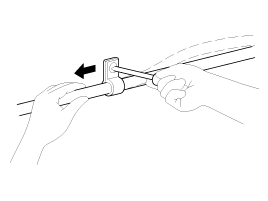 Hyundai Veloster: Checking Cables And Wires
Hyundai Veloster 2011-2017 Service Manual / General Information / Checking Cables And Wires
Hyundai Veloster: Checking Cables And Wires
Hyundai Veloster 2011-2017 Service Manual / General Information / Checking Cables And Wires
Hyundai Veloster 2011-2017 Service Manual / General Information / Checking Cables And Wires
| 1. |
Check the terminal for tightness.
|
| 2. |
Check terminals and wires for corrosion from battery electrolyte,
etc.
|
| 3. |
Check terminals and wires for open circuits.
|
| 4. |
Check wire insulation and coating for damage, cracks and degrading.
|
| 5. |
Check the conductive parts of terminals for contact with other
metallic parts (vehicle body and other parts).
|
| 6. |
Check grounded parts to verify that there is complete continuity
between their attaching bolt(s) and the vehicle's body.
|
| 7. |
Check for incorrect wiring.
|
| 8. |
Check that the wiring is so clamped to the prevent contact with
sharp corners of the vehicle body, etc. or hot parts (exhaust manifold,
etc.)
|
| 9. |
Check that the wiring is clamped firmly to provide enough clearance
from the fan pulley, fan belt and other rotating or moving parts.
|
| 10. |
Check that the wiring has a little space so that it can vibrate
between fixed and moving parts such as the vehicle body and the engine.
|
 Measurement Point
Measurement Point
Measurements should be taken at the center of the hole.
...
 Check Fuses
Check Fuses
A blade type fuse test taps provided to allow checking the fuse itself
without removing if from the fuse box. The fuse is good if the test lamp lights
up when one lead is connected to the tes ...
See also:
Gauges
Speedometer
The speedometer indicates the speed of the vehicle.
The speedometer is calibrated in miles per hour and/or kilometers per hour.
Tachometer
The tachometer indicates the approximate ...
Seat Heater. Schematic Diagrams
Circuit Diagram
...
Refrigerant label
The refrigerant label is located on the underside of the hood. ...
Categories
- Hyundai Veloster Manuals Home
- Hyundai Veloster 2010-2017 Owner's Manual
- Hyundai Veloster 2010-2017 Service Manual
В© 2011-2025 Copyright www.hvmanual.com

